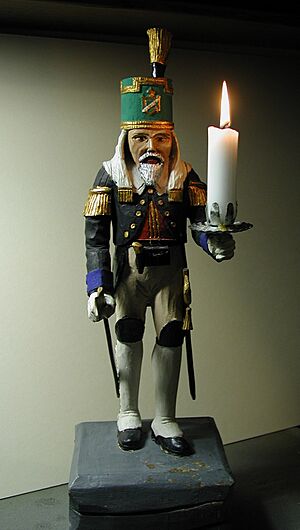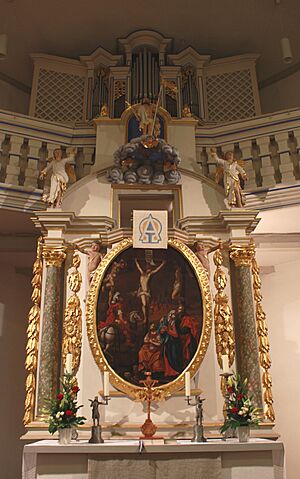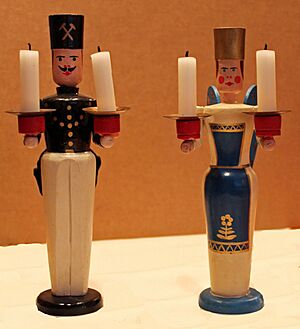Miner's figure facts for kids
A miner's figure (called Bergmannsfigur in German) is a special Christmas decoration. It comes from the Ore Mountains region in central Europe. These figures are usually made from wood, either by turning (spinning wood on a machine) or carving (shaping wood with tools).
Miner's figures often hold two candles. They are usually shown with an angel figure, which also holds a candle. This pair can represent different ideas. It might show the connection between men and women. Or it could symbolize the balance between everyday life and spiritual beliefs.
In the Ore Mountains, miner and angel figures are a big part of Christmas. Other popular decorations from this area include candle arches, smoking figures, and nutcrackers. Today, people all over the world place these candleholders on their windowsills. They help to bring light and cheer during long winter nights.
History of Miner's Figures
The Ore Mountains in Saxony, Germany, have been making these Christmas decorations since the 1800s. This region is famous for its high-quality Christmas crafts. Mining was once the main way people earned money here. But miners also enjoyed carving wood from the nearby forests. This hobby brought extra income to their families. This tradition of wood carving continues even today.
A Family Tradition
It was a special tradition for every man in the Ore Mountains. When he became a father, he would carve a miner or an angel for his child. A miner figure was carved for a son. An angel figure was made for a daughter.
Lights in the Window
At Christmas time, which is like a "fifth season" in the Ore Mountains, these figures were placed in windows. This way, people walking by could see how many children lived in the house. But the figures had another important purpose too. They became a symbol for the entire region.
Miners often went to work very early in the morning. It was still dark outside, especially in winter. Inside the mine, it was also dark, with only dim lights. When their long work shift ended, the moon was already in the sky. To help light the way for their men coming home in the dark, the women of the house would place these figures in the windows. They called them the Light Miner (Lichterbergmann) and the Light Angel (Lichterengel).
The angel became a special symbol for the religious mining people of the Ore Mountains. Angels were seen as guardians. They were also light-bearers on the dark and difficult path into the mine. Some people believed the wooden angels holding candles represented the miners' wives. They waited patiently for their husbands to return home safely.




